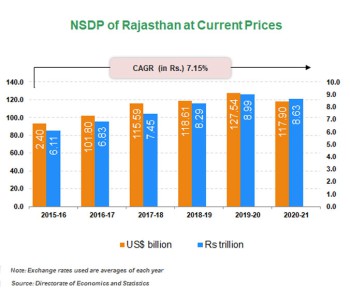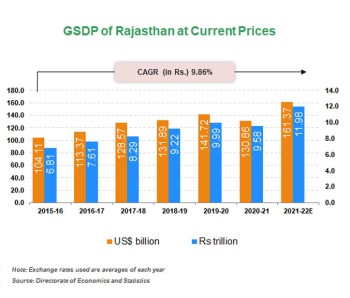INTRODUCTION
Rajasthan, the largest (area-wise) state in India, is in the northwest part of the subcontinent. It is surrounded on the north and the northeast by Punjab, Haryana, and Uttar Pradesh, on the east and southeast by Uttar Pradesh and Madhya Pradesh, and on the southwest by Gujarat.
The state has an agricultural economy with nine agro-climatic zones and various types of soil that help during the cultivation of crops. It is among the largest mineral-producing states in India. Around 81 varieties of minerals are available in the state and 57 minerals are produced on a commercial scale in the state. It also contributes significantly to production of dimensional and decorative stones, such as marble, sandstone, and granite etc.
The state is one of the leading tourist destinations in India. Historic palaces, especially those in Jaipur and Udaipur, offer opportunities to expand the luxury tourism segment, with increasing number of tourists visiting wildlife sanctuaries and desert locations.
Rajasthan’s Gross State Domestic Product (GSDP) increased at a CAGR (in Rs.) of 7.05% between 2015-16 and 2020-21. At a CAGR (in Rs.) of 10.86% between 2011-12 and 2020-21, the tertiary sector has been the fastest-growing sector and the largest contributor to Rajasthan’s economy in 2020-21, with a 45.44% share in the state’s GSVA. The growth was driven by storage, communication & services related to broadcasting, financial services and public administration.
In 2020, 40 investment intentions were filed in the state with total investment of Rs. 12,698 crore (US$ 1.71 billion). As of February 2020, the state was home to three operational Special Economic Zone (SEZs), four notified SEZs, one SEZ with an in-principle approval and five SEZs with formal approvals.
According to the Department for Promotion of Industry and Internal Trade (DPIIT), Foreign Direct Investment (FDI) inflow in the state stood at US$ 461.40 million between October 2019 and March 2021.
The policy environment has been favorable for the establishment of industrial units. A single window clearance system (SWCS) for investment approvals is operational in the state and the Bureau of Investment Promotion (BIP) was set up to focus on investment above US$ 2.2 million. Rajasthan stands sixth among Indian states in rankings based on ease of doing business and reforms implementation as per a study by the World Bank and KPMG.
In FY21, the total exports of plywood & allied products from Rajasthan stood at US$ 418.07 million (~6%).



KEY SECTORS
- The state is the leading producer of cement-grade limestone in India. Production of limestone reached 31.04 million tonnes in April-September 2020.
- In January 2021, Chief Minister Mr. Prem Singh Golay launched ‘Visit Sikkim 2022’, a declaration on year-long tourism promotion and marketing for Sikkim. He emphasised on having tourists in Sikkim for the whole year, instead of otherwise practised season-based tourism endeavour.
- Tourism is one of the key sectors in the state. In 2019, 52.22 million domestic tourists and 1.60 million foreign tourists visited Rajasthan.
- Mining and Mineral Processing is another key sector for the state. Export of Zinc and Products made of Zinc reached US$ 273.34 million in FY21.
- In September 2020, value of all minerals produced^ in the state stood at Rs. 911.45 crore (US$ 122.87 million).
- Food grain production was estimated to have reached 24.98 million tonnes in 2019-20. Production of cereals and pulses was estimated at 20.49 million tonnes and 4.49 million tonnes during the same period.
Note *Excluding Fuel, Atomic and Minor Minerals